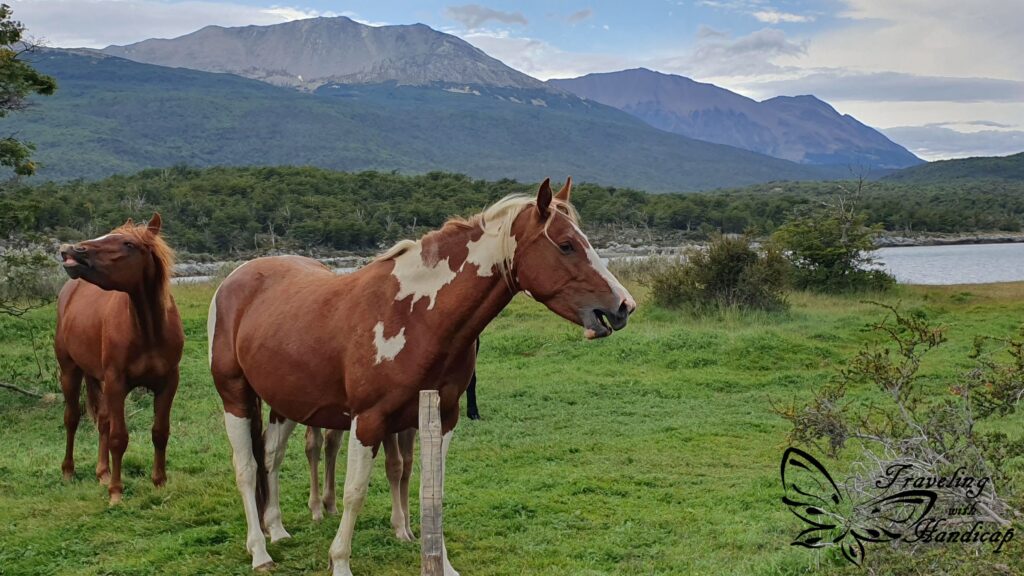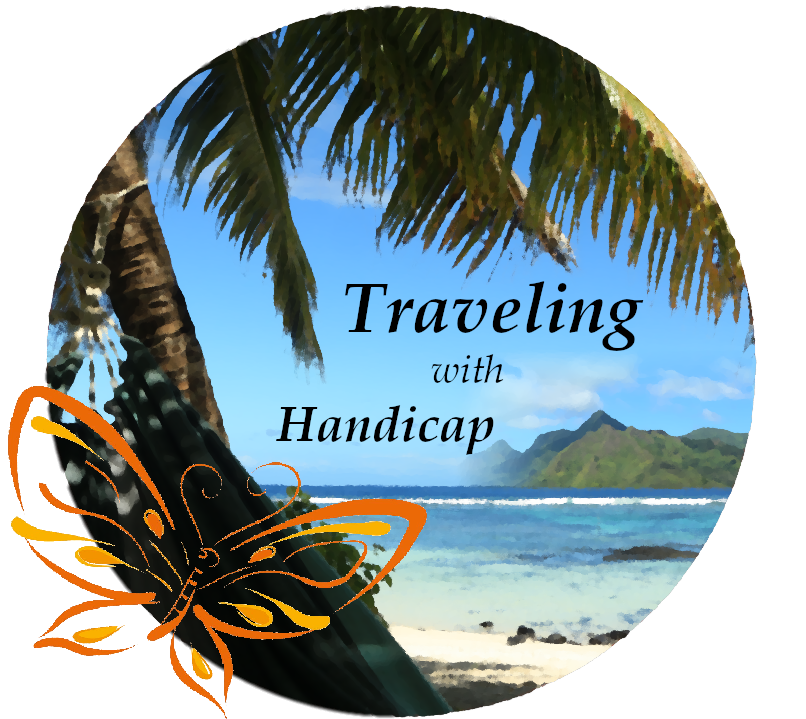If you are chosen town clerk, forsooth,
you cannot go to Tierra del Fuego this summer;
but you may go to the land of infernal fire nevertheless.
Henry David Thoreau
My goal is to travel across South America, from south to north. I have already been in Puerto Natales and Punta Arenas, the southernmost city of Patagonia. However, south of the Magallanes Strait are a couple of islands, Tierra del Fuego. Sometimes, Tierra del Fuego is counted as the southern tip of Patagonia, I’d consider it as a separate part/region.
Long distance bus trips
So before heading up north, I had to go south-south, visiting Tierra del Fuego with its southernmost city, Ushuaia. It’s not as close to Punta Arenas as it looks on the map, I had to take a full-day bus trip. In general, I try to cover as much as possible by bus, to avoid flying. Moreover, you can enjoy good views from the bus without the hassle of driving, fuel stations, staying awake within hours of non-changing surroundings. If it gets too boring to watch the surrounding nature, you might just chill. During such bus-trips, my e-reader is a very trustworthy friend. 🙂
Bus companies down south
There are some bus companies based in Puerto Natales that offer transport to Torres del Paine. Mainly, Bus-Sur, Fernández, Turismo Zaahj. There are also offices of Marga Taqsa and other small companies. I stuck to Bus-Sur for as long as possible, since I had a perfect experience on my first trip. Ticket prices might vary a little, but not really in a price range that clearly distinguishes the operators.
For my trip to Ushuaia, I could pick between Bus-Sur and Marga Taqsa. The trip down was better with Bus-Sur since I didn’t have to stay in Rio Gallegos overnight to catch the connection bus in the morning. Bus-Sur made it available as a “one-day-trip”. The trip from Ushuaia to El Calafate is too long to be done only during daylight hours. Marga Taqsa offered the 3am bus from Ushuaia arriving in El Calafate late at night. This journey included a multi-hour wait in Rio Gallegos. I went with Bus-Sur from Ushuaia to Puerto Natales (the same route as I took south), stayed in Puerto Natales for a night and took the morning bus to El Calafate the next day.
Accessibility
The long distance buses are not accessible, it’s even difficult for me to get up and down the stairs after many hours of sitting. So I am glad whenever a driver or staff person recognizes my struggles and lends me a hand for the first/last high step. I have not recorded anyone taking the bus who had some visible disability. Especially when the distances get really long, I’d recommend taking the plane if you have a wheelchair.
Honestly, Patagonia, Tierra del Fuego, the south, is really great for outdoor enthusiasts. However, hiking is not really the number one activity if you are in a wheelchair or blind, so you might skip the hiking-hubs and instead stick to the bigger towns (with airports) that offer tours.
Tierra del Fuego
Similar to Patagonia, Tierra del Fuego is split between Chile and Argentina. I have visited Tierra del Fuego twice, once on a tour from Punta Arenas covering some spots on Chilean Tierra del Fuego. The second time, I took a long-distance bus from Puerto Natales to Usuhaia on the Argentinean side of Tierra del Fuego.
Chilean Part
In my post on Puerto Natales and Punta Arenas, I already mentioned my tour to Tierra del Fuego. After crossing the Magallanes Strait with the ferry from the Punta Delgada Lighthouse, I was finally in Tierra del Fuego. The crossing only took approximately 20 minutes. Looking out of the window, the landscape is similar to the surrounding of Punta Arenas, little smooth hills, no high trees, and plenty of sheep and guanacos. Guanacos are related to the alpaca, which also lives in the Andes but further up north.



We’ve been told by the guide that there are more guanacos on Tierra del Fuego than people. This reminded me of New Zealand, having more sheep than Kiwis. Our guide explained everything in Spanish, me and one other guide asked him in English if something wasn’t clear enough. I was quite proud that I could follow many explanations. I still struggle to remember all the words I would use for a basic conversation, which goes beyond the classical basic level stuff.
Our first stop on the island was Cerro Sombrero, a town built and constructed for the employers working on the surrounding plants. I only recognized one man walking around, apart from that, the whole town was kinda dead. There must have been people on the plants working. However, I don’t expect many women working on the plants, so this might be a quite male town, also without kids. Cerro Sombrero has a church, a cinema, community hall, casino and the only swimming pool (not natural) of Tierra del Fuego. When we stopped, I took photos of those mentioned buildings. Except from the cinema, they looked so crappy and broken, not sure if they are still usable.
The king penguins
You are only allowed to stay with the penguins for one hour and only a limited amount of people. Due to the really strong winds, one hour is definitely enough! Some more recent Chilean law sais that you are only allowed to watch the penguins from a certain distance. There are shelters provided at the respective distance, you already have a good view without zoom. There have been some wildlife photographers on my tour, they carried super-zoom lenses. However, the wind made it impossible to stabilize their huge and expensive equipment. I used some mounted goggles for the zoom view and even tried my phone-lens on it (as it’s small enough). The pictures turned out surprisingly well.
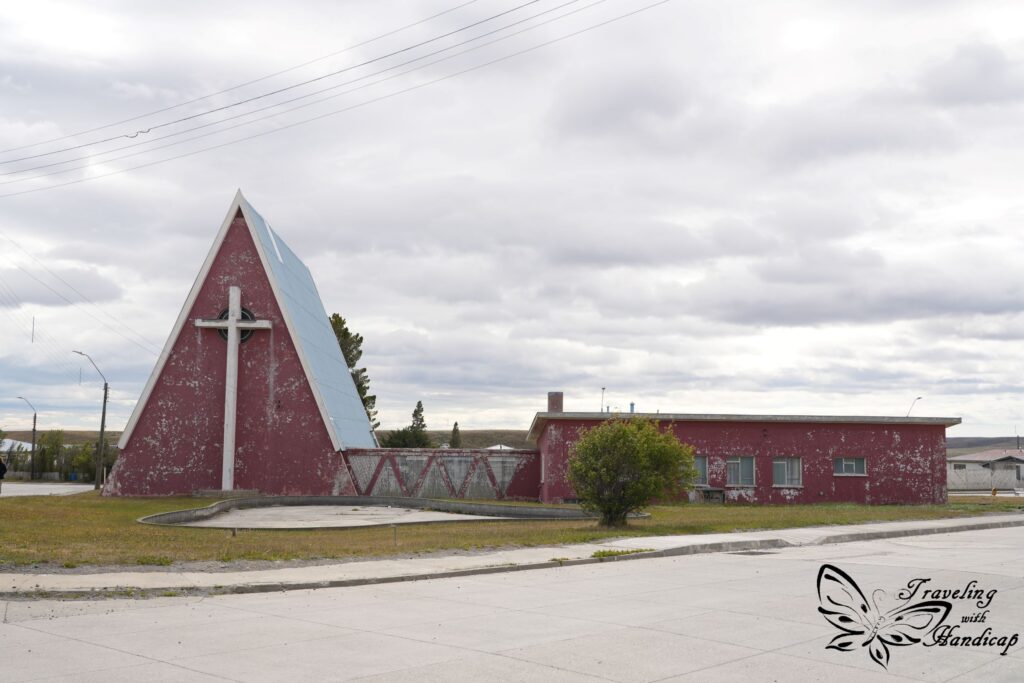



Porvenir
After the penguins, we drove to Porvenir, the only bigger town on Chilean Tierra del Fuego. Even though Porvenir has a certain size and looks more liveable than Cerro Sombrero or the Estancias I’ve seen, it is still quite tiny. It looks – and maybe also serves? — as a connection from the busy hub of Punta Arenas to Tierra del Fuego. There are (on average) two big ferries a day connecting Punta Arenas and Porvenir, however, not at the same time each day. So the days on which the tour is available actually depend on the ferry crossing schedule from Porvenir to Punta Arenas.
We cruised around some lakes around Porvenir. First, we stopped at Lago Verde with its turquoise colored water. Secondly, the Parque Estromalitos at Lago los Cisnes. Stromatolites are the oldest, ancient, still living animals which are only found on a few specific places around the globe. I’m not a biologist or geologist, but more detailed information can be found on Wikipedia for everyone who is interested.

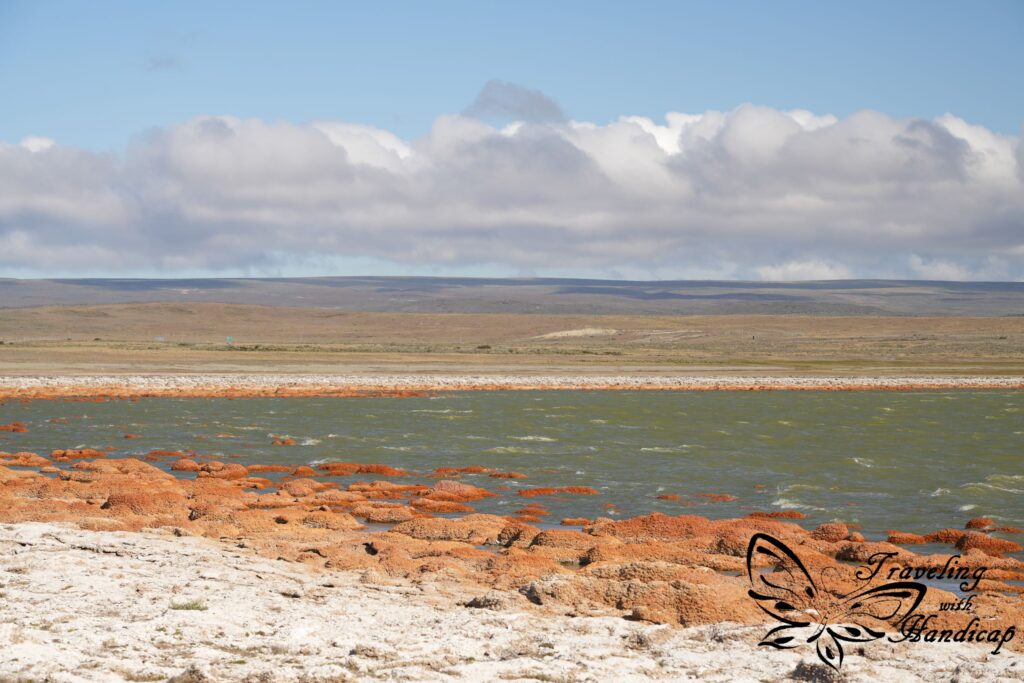

Porvenir is a cute small town. Its houses were very colorful, a nice contrast to the brown and dry surrounding landscape (which might be all white during winter time). After a very late “lunch” (rather early dinner for me) in Porvenir, we walked around before we had to head to the ferry. The crossover to Punta Arenas was quite late on that day, so this made up a total of 16 hours for the whole tour. So it was definitely worth the money (even though Chile is not cheap).





Argentinean Part
Border crossings Chile – Argentina
In order to get to Ushuaia, I had to cross a border on land. The Argentinean part of Tierra del Fuego can only be entered on land after crossing Chilean Tierra del Fuego. So there is no direct land-ferry-connection from Argentina to Argentina. On the way south, this was as expected, leaving Chile to enter Argentina. When coming back up north, from Ushuaia to El Calafate (both Argentina), I had to enter and leave Chile again, as there is no other route.
The border crossings took a while but were very organized. This was due to the circumstances that they always took care of all bus passengers as one pack. We had to wait until the previous bus was settled before we left our bus for the stamping and registration. When entering Chile, your small bags are scanned (and dogs check the big bags in the trunk for fruit) and this has also been done for all people on the bus as one pack. While the border crossings out of / into Mexico felt unorganized too long, these were very organized.
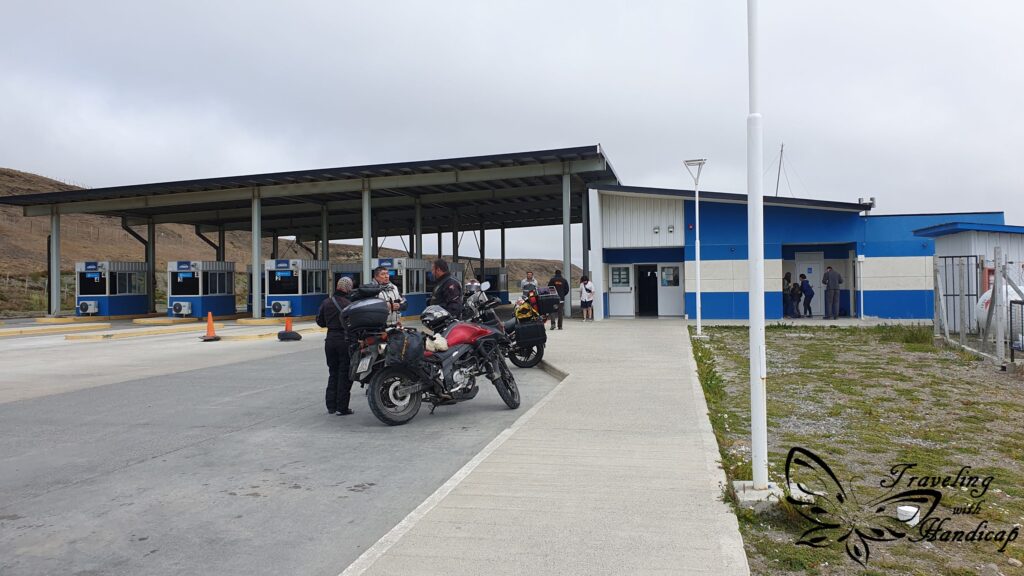


Ushuaia
When I got the first glimpse of a view on Ushuaia, I was really surprised upon its size. I expected something like Porvenir, but Ushuaia is huge. So it deserves to be called the southernmost city (!) of the world. There is the more touristy part close to the port, and the more local a bit further away. I walked around in the touristy part, especially the main street and the street along the coast. On the bus to the national park, I got a glimpse of the more local parts of Ushuaia.
There are many cafés and hiking stores, since there are also great hiking possibilities around Ushuaia, even a glacier to hike up directly from town. I met people who stayed in Ushuaia a couple of weeks, hiking every single mountain. That’s not worth it in my opinion, since there are so many other cool hikes to do at other places in Patagonia, so I would rather visit different places.




Gateway to Antarctica
I only spent 2.5 days in Ushuaia, comparatively short for the multi-hour bus ride which is required to get there. However, Ushuaia is expensive for Argentinean circumstances. Since many tours to Antarctica leave from Ushuaia and many people from especially the States are just here for the tours, they may charge more. If you have the money to pay for the tour to Antarctica, you can afford a little more for accommodation and food. I decided not to get on a boat, even the “last minute options” were too expensive for my budget. With that money, I can travel to other places for 2–3 months.
National Park Tierra del Fuego
Next to the bus station of Ushuaia, there is a little colectivo terminal. Colectivos leave at specific times a day to specific locations for fixed prices (return tickets). This makes getting around easy. I got the colectivo booked through my hostel (for the fixed price) and they picked me up in the morning. There are three different stops in the park for the colectivos, it depends on what you want to do.
I went to the third and last stop and considered walking back to the second spot and walking a little up and down the lake close to stop two. The weather was great, not too windy. However, the tracks were so much easier than expected. At the southernmost end of the road connecting Buenos Aires to the south, many bus tourists stopped. These only had a short photo stop and continued. At the restaurant where I got on the bus on my way back, other bus tourists (from the States) had an extensive lunch.
